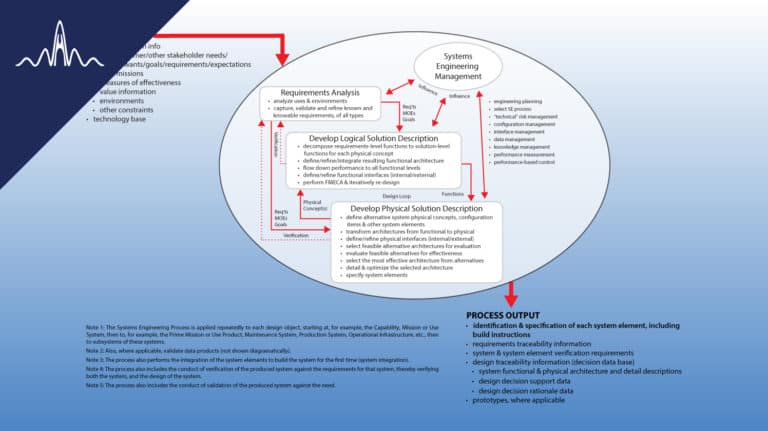Commonalities:
1. PPI’s Football Diagram uses the same graphical concept.
Differences:
1. MIL-STD-499B makes no provision for concurrent (simultaneous) engineering. PPI’s Football Diagram makes explicit provision for concurrent engineering.
2. MIL-STD-499B uses the term “Functional Analysis” synonymously with “develop functional solution”, ignoring the fact that functional analysis is a technique which has application in both requirements analysis and design. PPI’s Football Diagram defines process elements that make a clear distinction between a. requirements capture and validation and b. design.
3. MIL-STD-499B uses the term “Allocation” in an unconventional way (flow down of performance from requirements level functions to solution level functions) rather than the conventional (allocate a solution level function to a system element for the performance of that function). PPI’s Football Diagram uses the term “Allocation” in a conventional and appropriate way.
4. MIL-STD-499B “Requirements Loop” emphasizes iteration between functional requirements and functional design, which is an undesirable emphasis, and in any event, any iteration applies no less to physical design (synthesis). Any need for iteration between requirements and design is to be minimised through effective capture and validation (requirement analysis), not emphasized. PPI’s Football Diagram has requirements driving design. Designing a solution doesn’t change the problem.
5. MIL-STD-499B System Analysis and Control mixes up engineering management, verification and mainstream design decision-making activities in an undesirable way. PPI’s Football Diagram makes a clear process element distinction between design, verification, validation and engineering management.
6. MIL-STD-499B System Analysis advocates technical reviews for progress measurement, not design verification. PPI’s Football Diagram makes explicit provision within the football for verification of design against requirements.
7. In MIL-STD-499B, verification is not shown for Functional Analysis / Allocation. PPI’s Football Diagram shows design verification for both physical and functional design.
8. The MIL-STD-499B diagram places effectiveness analysis / trade studies / design decision making outside of the design loop. This is neither logical nor helpful. PPI’s Football Diagram has the evaluation of and decision between design alternatives as a design activity.
9. The MIL-STD-499B engineering management activities list is seriously incomplete (under “Systems Analysis and Control). PPI’s Football Diagram provides a list of engineering management concerns that are conducive to project success.
10. In MIL-STD-499B there is no recognition of validation or system verification or integration. PPI’s Football Diagram explicitly emphasizes validation of system requirements, validation of system design, and validation of the system. PPI’s Football Diagram explicitly emphasizes system verification. PPI’s Football Diagram explicitly emphasizes system integration.
11. The words “design constraint requirements”, “balanced system solutions” are used loosely in MIL-STD-499B. PPI’s Football Diagram does not use these terms. Without definition in MIL-STD-499B, who knows what they were intended to mean!
12. The MIL-STD-499B list of outputs is seriously incomplete. PPI’s Football Diagram provides an appropriate list of the major outputs from “the left hand side of the vee”.







